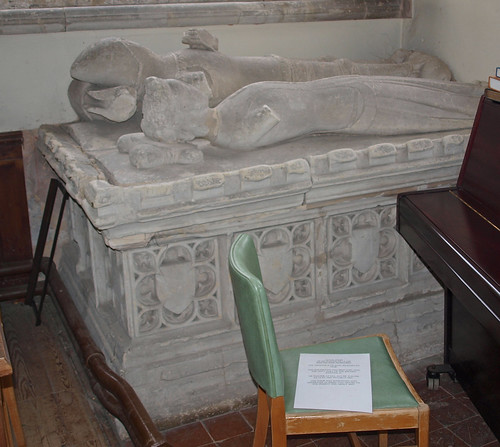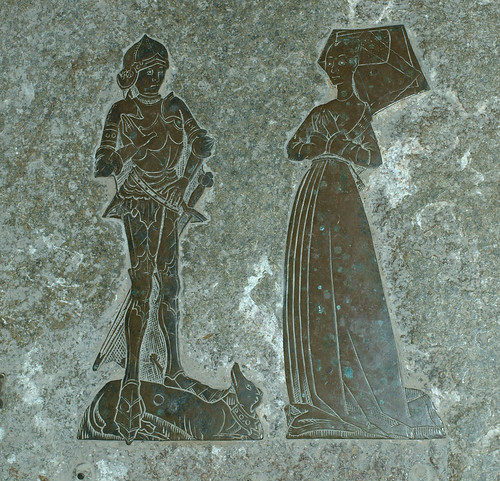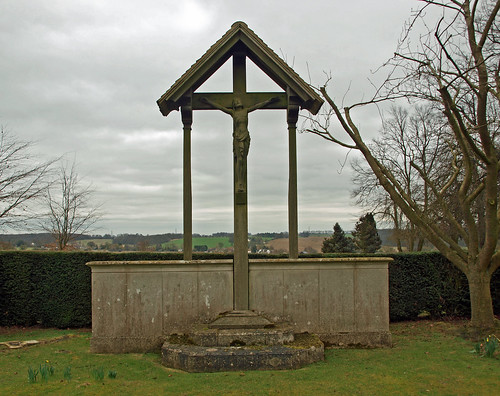I visited St Mary's, Albury in March as
part of my mission to catalogue all reasonably local churches in my area
and then, subsequently and unexpectedly, discovered that the
Barlee/Barley monuments are directly linked to a paternal 19th great
grandfather. Extraordinary to think that a very local church to where I
grew up has links to part of my heritage extant in the C15th and I never
knew about the connection until very recently!
There's also a much damaged monument to Sir Walter de la Lee and his wife - the damage that was done to monuments and church decor in our past always surprises me but not as much as some Victorian, and later, restoration (the worst I've seen to date was in Arkesden which I think I will show in its full horror in a later post). Being a great corbel fan I get terribly depressed when I visit a church and find that they've all been hacked off or defaced but not, I think, as angry as I get about the deliberate defilement of someones tomb. This deliberate damage to the de la Lee's effigies strikes me as criminal.
ST MARY. As in so many churches in this neighbourhood the chancel is the earliest surviving part: C13 with original N and S lancet windows. The nave and aisles are mid CI4, as shown by the aisle windows with very unusual, rather ugly, heavily flowing tracery. The arcades have piers with big round shafts and thin shafts in the diagonals. The arches are two-centred and double-chamfered in the S, more complex in the N. The chancel arch is of the same style, the very tall tower arch evidently a hundred years later. The tower has diagonal buttresses, a low stair-turret, and a spike. - PULPIT. C18 with inlaid shield. - SCREEN. Tall, C15. - PLATE. Chalice, 1626. - MONUMENTS. Tomb-chest with five quatrefoils with shields. On it the defaced efligies of a Knight and a Lady of c. 1400. - Brass to a Knight in armour and his Lady, elegant somewhat mannered figures of under 1 1/2 f t length, c. 1475 (nave floor). - Brass to Thomas Leventhorp d. 1588 and wife and children; husband and wife turned towards each other (S aisle). - Brass to John Scrogs d. 1592 with wife and child; one plate with tapering sides.
Flickr set.
There's also a much damaged monument to Sir Walter de la Lee and his wife - the damage that was done to monuments and church decor in our past always surprises me but not as much as some Victorian, and later, restoration (the worst I've seen to date was in Arkesden which I think I will show in its full horror in a later post). Being a great corbel fan I get terribly depressed when I visit a church and find that they've all been hacked off or defaced but not, I think, as angry as I get about the deliberate defilement of someones tomb. This deliberate damage to the de la Lee's effigies strikes me as criminal.
ST MARY. As in so many churches in this neighbourhood the chancel is the earliest surviving part: C13 with original N and S lancet windows. The nave and aisles are mid CI4, as shown by the aisle windows with very unusual, rather ugly, heavily flowing tracery. The arcades have piers with big round shafts and thin shafts in the diagonals. The arches are two-centred and double-chamfered in the S, more complex in the N. The chancel arch is of the same style, the very tall tower arch evidently a hundred years later. The tower has diagonal buttresses, a low stair-turret, and a spike. - PULPIT. C18 with inlaid shield. - SCREEN. Tall, C15. - PLATE. Chalice, 1626. - MONUMENTS. Tomb-chest with five quatrefoils with shields. On it the defaced efligies of a Knight and a Lady of c. 1400. - Brass to a Knight in armour and his Lady, elegant somewhat mannered figures of under 1 1/2 f t length, c. 1475 (nave floor). - Brass to Thomas Leventhorp d. 1588 and wife and children; husband and wife turned towards each other (S aisle). - Brass to John Scrogs d. 1592 with wife and child; one plate with tapering sides.
Albury.
The River Ash trickles through the valley below, and on neighbouring
hilltops are Albury Lodge and Upwick Hall, both with 17th century
panelling and oak doorways older still, while the gardener at the hall
lives in a cottage 500 years old.
Near the church is a 16th-century timbered house with leaning walls, and beyond is an inn with a ready-made text in its sign, The Labour in Vain. In summer the scent of lime and syringa steals into the church, where are also the fresh colour and coolness of trees, for the 13th century chancel, behind its screen of 15th century tracery, has been entirely panelled in white oak, with new seats and an altar rail to match, all set against a carpet as green as leaves. The nave, the aisles, and the chancel arch are 14th century; the pinnacled tower and needle spire and two of the bells were added in the 15th, and the porch soon afterwards. There is an ancient iron-bound chest with four locks, some 15th-century ironwork on the door to the tower staircase, a 17th century altar table, and a pulpit made up of Jacobean panelling inlaid with the arms of the Leventhorpes.
Thomas Leventhorpe, who died in 1588, is pictured in brass with his wife and six daughters; an unknown knight and his dainty lady are shown with their four daughters; and thinly scratched on a rough sheet of brass are John Scrogs, his wife and child, some shields and a skull, and the date 1592. Another brass shows the arms of Anne Barley and tells of money left by her to buy bread for the poor. In his armour on an altar tomb lies one of Richard II’s knights, his wife beside him in the simple dress of the end of the 14th century. He may be Sir Walter de la Lee, but his name is lost, and he remains an unknown soldier, like many of those who knelt before the crucifix in the chapel, for this came from the hospital chapel at Wimereux in France, placed here by the chaplain in memory of all who died in that hospital during the Great War. The altar cloth was also brought from there.
Near the church is a 16th-century timbered house with leaning walls, and beyond is an inn with a ready-made text in its sign, The Labour in Vain. In summer the scent of lime and syringa steals into the church, where are also the fresh colour and coolness of trees, for the 13th century chancel, behind its screen of 15th century tracery, has been entirely panelled in white oak, with new seats and an altar rail to match, all set against a carpet as green as leaves. The nave, the aisles, and the chancel arch are 14th century; the pinnacled tower and needle spire and two of the bells were added in the 15th, and the porch soon afterwards. There is an ancient iron-bound chest with four locks, some 15th-century ironwork on the door to the tower staircase, a 17th century altar table, and a pulpit made up of Jacobean panelling inlaid with the arms of the Leventhorpes.
Thomas Leventhorpe, who died in 1588, is pictured in brass with his wife and six daughters; an unknown knight and his dainty lady are shown with their four daughters; and thinly scratched on a rough sheet of brass are John Scrogs, his wife and child, some shields and a skull, and the date 1592. Another brass shows the arms of Anne Barley and tells of money left by her to buy bread for the poor. In his armour on an altar tomb lies one of Richard II’s knights, his wife beside him in the simple dress of the end of the 14th century. He may be Sir Walter de la Lee, but his name is lost, and he remains an unknown soldier, like many of those who knelt before the crucifix in the chapel, for this came from the hospital chapel at Wimereux in France, placed here by the chaplain in memory of all who died in that hospital during the Great War. The altar cloth was also brought from there.


